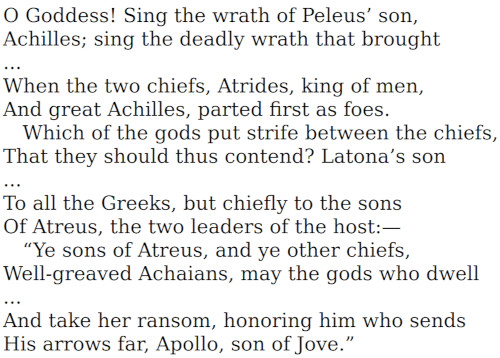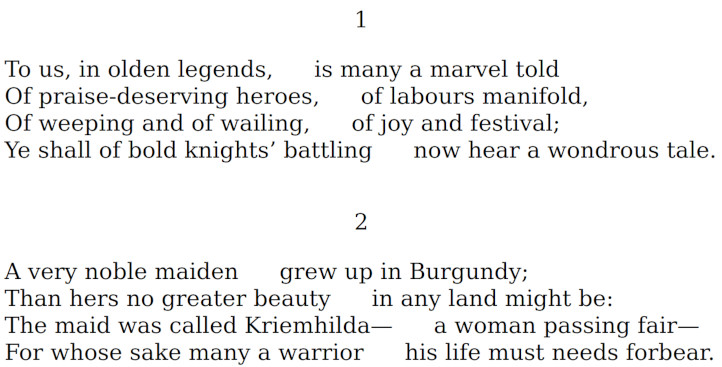How to Structure and Style Large Poetic Productions
The presentation of poems can take various styles and forms. Unlike prose, the structure of a poem adds additional meaning through indentations, line breaks, caesuras, spacing, and even the shape of the text. Here is a guide to help with some of poetry’s less intuitive formatting.
Table of Contents
-
Splitting files
Unlike prose, short poems are not placed in individual files like chapters. The rule of thumb is to split poetic productions by the highest-level division(s) possible. A production can result in a single collections file of an author’s short poems or multiple files for longer poetic works, like long narrative poems, that have main divisions.
A single collections file
For most poetry collections, they utilize a single collections file that contains all of an author’s short poems, ordered by date of publication. If the collection is made up of multiple books, you don’t need to group the poems by the books’ titles. This file is named
poetry.xhtmland has a<title>element with the valuePoetry.<?xml version="1.0" encoding="utf-8"?> <html xmlns="http://www.w3.org/1999/xhtml" xmlns:epub="http://www.idpf.org/2007/ops" epub:prefix="z3998: http://www.daisy.org/z3998/2012/vocab/structure/, se: https://standardebooks.org/vocab/1.0" xml:lang="en-US"> <head> <title>Poetry</title> <link href="../css/core.css" rel="stylesheet" type="text/css"/> <link href="../css/local.css" rel="stylesheet" type="text/css"/> </head> <body epub:type="bodymatter z3998:fiction"> <article id="imitation-of-spenser" epub:type="z3998:poem"> <h2 epub:type="title">Imitation of Spenser</h2> <p> <span>...</span> </p> </article> <article id="on-death" epub:type="z3998:poem"> <h2 epub:type="title">On Death</h2> <p> <span>...</span> </p> </article> ... </body> </html>Multiple files
In the world of poetry, long narrative poems are a unique form of expression that often use books or cantos as the main divisions, serving a similar purpose to chapters in a novel. These divisions are placed in their own individual files. These files have both
chapterandz3998:poemsemantics.<?xml version="1.0" encoding="utf-8"?> <html xmlns="http://www.w3.org/1999/xhtml" xmlns:epub="http://www.idpf.org/2007/ops" epub:prefix="z3998: http://www.daisy.org/z3998/2012/vocab/structure/, se: https://standardebooks.org/vocab/1.0" xml:lang="en-GB"> <head> <title>Book I</title> <link href="../css/core.css" rel="stylesheet" type="text/css"/> <link href="../css/local.css" rel="stylesheet" type="text/css"/> </head> <body epub:type="bodymatter z3998:fiction"> <section id="book-1" epub:type="chapter z3998:poem"> <header> <h2> <span epub:type="label">Book</span> <span epub:type="ordinal z3998:roman">I</span> </h2> <p epub:type="bridgehead">The Trojans, after a seven years’ voyage...</p> </header> <p> <span>...</span> </p> </section> </body> </html> -
Manual transcription
In some cases, working on a large omnibus compilation involves working with poems whose HTML transcriptions are crude or nonexistent. Transcribing poetry, while an advanced production technique, is somewhat more feasible than transcribing prose because of the much smaller amount of text compared to prose. However, poetry formatting (e.g. indentation) poses some challenges for transcription. Manually inserting the whole array of
<span>elements and breaks would be unwieldy at best. Instead, it can be easier to use a shell script to convert temporary markup into the final desired HTML:#!/bin/bash
# Repeat this descending pattern for more indentation levels se interactive-replace 'v####(.*)' '<span class="i3">\1</span><br/>' $1 se interactive-replace 'v###(.*)' '<span class="i2">\1</span><br/>' $1 se interactive-replace 'v##(.*)' '<span class="i1">\1</span><br/>' $1 se interactive-replace 'v#(.*)' '<span>\1</span><br/>' $1 se interactive-replace '<br/>\s+</p>' '</p>' $1 se clean $1Here is an example of the temporary markup:
<p> v#This line is not indented. v##This line is at i1. v###This line is at i2. v####This line is at i3. </p>Running the script on this file produces this HTML:
<p> <span>This line is not indented.</span> <br/> <span class="i1">This line is at i1.</span> <br/> <span class="i2">This line is at i2.</span> <br/> <span class="i3">This line is at i3.</span> </p> -
Modernizing poetic works
Do not run
se modernize-spelling .on poetry projects. Because changes can affect the rhythm of poetry, we generally do much less modernization than for other projects, so words like “to-day” and “some one” wouldn’t be modernized as they usually would be.Modernize prose frontmatter and backmatter
Prose elements, such as poem titles, dedications, prefaces, and endnotes should have spelling, hyphenation, spacing in select words modernized as normal. See the step “Modernizing Spelling and Hyphenation” in the Step by Step guide.
You can target specific files with the
se modernize-spellingtool.se modernize-spelling src/epub/text/preface.xhtml se modernize-spelling src/epub/text/endnotes.xhtmlModernize poems carefully!
The
se modernize-spellingtool can modernize word spellings without dehyphenating words, but for poetry you must still carefully review each change to ensure it does not affect the sound of the line.se modernize-spelling --no-hyphens src/epub/text/book*Modernization exceptions
While there are no set guidelines, it’s worth noting that there are certain situations where it is advisable to preserve the original spelling. To help with this, here’s a list of specific scenarios where modernizing the spelling may be incorrect.
-
Hyphenations and spacings
Hyphenations and spaces in poetry are fundamental elements that contribute to the visual and auditory experience of a poem. Hyphenations can serve to emphasize certain syllables or create rhythmic patterns within lines. The placement of spaces can influence the pacing, tone, and meaning of a poem. Together, they convey the poet’s intended message or evoke certain emotions in the reader. Modernizing spelling can erase a poet’s intended styling.
-
Mismatched diacritics
In the realm of poetry, diacritics play an important role. They are utilized for multiple reasons, such as marking stresses on less common syllables, clarifying emphasis in cases where the distinction is metrically significant, or indicating the pronunciation of typically silent letters.
The
se find-mismatched-diacriticstool will flag these for review. Make sure to verify that the diacritics match the source scans.... <span>The wingèd hounds of Winter ceased to bay.</span> <br/> <span>The stupor of a doom completed lay</span> ... -
Unusual pronunciations
In poetry, a perfect rhyme scheme is sometimes achieved by using archaic words that may have a different pronunciation from their modern counterparts. This technique enables the poet to maintain a consistent rhyme pattern throughout their work.
In the example,
se modernize-spellingwill want to change “sate” to “sat” and “shew” to “show”, but these words are not sound-alike changes.... <span>Where Dankwart with his yeomen still at the table sate;</span> <br/> <span>There rose between the heroes a strife of deadly hate.</span> ... <span>Shone never on a braver scene than that.</span> <br/> <span>Here was a prison, there a Man who sat</span> ... <span>The flowers de luce, and the sparks of dew</span> <br/> <span>That hung upon their azure leaves did shew</span> ... <span>Its solid truth seems change to undergo;</span> <br/> <span>Its largest square doth yet no corner show</span> ... -
Eye rhymes
In some cases, a poet is unable to create a perfect rhyme, resorting to an eye rhyme. An eye rhyme, also called a visual rhyme, is when two words are spelled similarly but pronounced differently.
In the example, the poet uses the obsolete spelling of “die” to create a visual rhyme.
... <span>The beasts we daily see massacred dy</span> <br/> <span>...</span> <br/> <span>And men themselves do change continually,</span> ... -
Uncommon contractions
Poetry often employs uncommon contractions that are considered as an essential part of its style. These contractions are best left unchanged.
... <span>Thanks, i’ faith, for silence is only commendable</span> ... <span>That he is constant; for i’faith I swear,</span> ... <span>Stand to ’t (quoth she) or yield to mercy:</span> ... <span>I have bound thee to’t by death.</span> ... -
Archaisms
Some poets use archaisms to imitate very old or antiquated styles of English spellings to make the work seem older.
<p> <span>The Patron of true Holinesse</span> <br/> <span>Foule Errour doth defeate;</span> <br/> <span>Hypocrisie, him to entrappe,</span> <br/> <span>Doth to his home entreate.</span> </p>
-
-
Unusual formatting
Poetry is a diverse art form that offers a wide range of distinctive types, each with its own unique visual appeal. In fact, poetry can take on various unconventional formats that add to its artistic charm. Below are some uncommon formatting styles you may come across while producing a poetry production.
Verse paragraphs
In poetic composition, some authors opt to use stanzas of varying length. While traditional poetry forms such as sonnets and haikus have a set structure, free verse poetry allows poets to experiment with different stanza lengths. To visually differentiate between stanzas, some poets choose to remove the blank space between them and instead indent the first line of each subsequent stanza (excluding the first stanza). This technique serves a similar function to paragraphs in prose.

With a clever CSS selector, you don’t need to add the
i1class to each stanza. To remove spacing between stanzas, delete[epub|type~="z3998:poem"] p + p{ margin-top: 1em; }that’s provided by the SEMoS.<p> <span>O Goddess! Sing the wrath of Peleus’ son,</span> <br/> <span>...</span> <br/> <span>And great Achilles, parted first as foes.</span> </p> <p> <span>Which of the gods put strife between the chiefs,</span> <br/> <span>...</span> <br/> <span>Of Atreus, the two leaders of the host:—</span> </p> ...[epub|type~="z3998:poem"] p + p > span:first-child{ padding-left: 2em; text-indent: -1em; }Caesuras
In poetry, a caesura is a pause or break in a verse that marks the end of one phrase and the beginning of another. This pause can be expressed by a large space and is used by poets to create a rhythmic effect in their work.

In the files, wrap each phrase in a
<span>element inside of the<span>element that represents the complete verse line.<p> <span> <span>To us, in olden legends,</span> <span>is many a marvel told</span> </span> <br/> <span> <span>Of praise-deserving heroes,</span> <span>of labours manifold,</span> </span> <br/> <span> <span>Of weeping and of wailing,</span> <span>of joy and festival;</span> </span> <br/> <span> <span>Ye shall of bold knights’ battling</span> <span>now hear a wondrous tale.</span> </span> </p>span > span + span{ margin-left: 1.5em; }Dropped lines
A dropped line is a stylistic technique in which a single line of verse is divided into two or three distinct phrases. This technique is similar to the use of caesuras, although it differs in that the breaks do not appear in every line, and the phrases themselves are separated by line breaks rather than a large space.
When dealing with two separate phrases, the parent
<span>has aclass="dl2"attribute.
... <span>Rooms in the house for sleeping. The old men</span> <br/> <span class="dl2"> <span>And ladies slept within the mansion.</span> <span>Thaddeus</span> </span> <br/> <span>Received command to lead the younger men</span> ....dl2 span:first-child{ vertical-align: 100%; }In the rare case that a line is broken into three phrases, the parent
<span>has aclass="dl3"attribute.
... <span>But blow one blaring trumpet note of sun</span> <br/> <span class="dl3"> <span>To go with me</span> <span>to the darkness</span> <span>where I go.</span> </span> ....dl3 span:first-child{ vertical-align: 200%; } .dl3 span:nth-child(2){ vertical-align: 100%; }